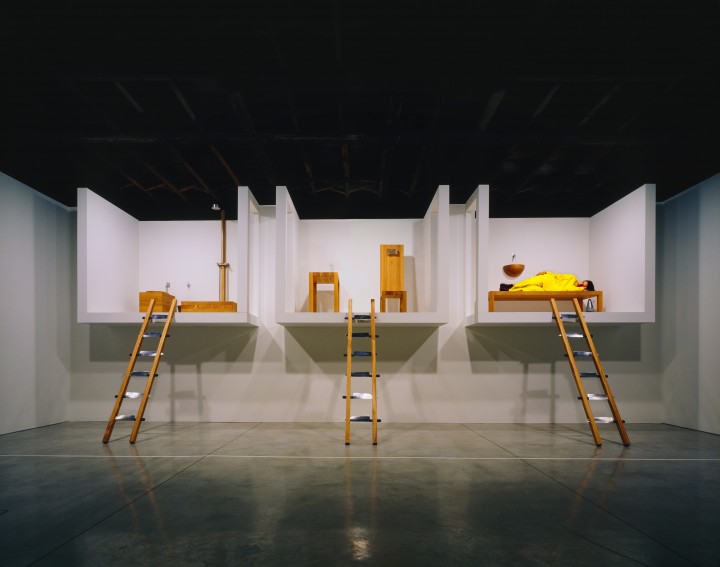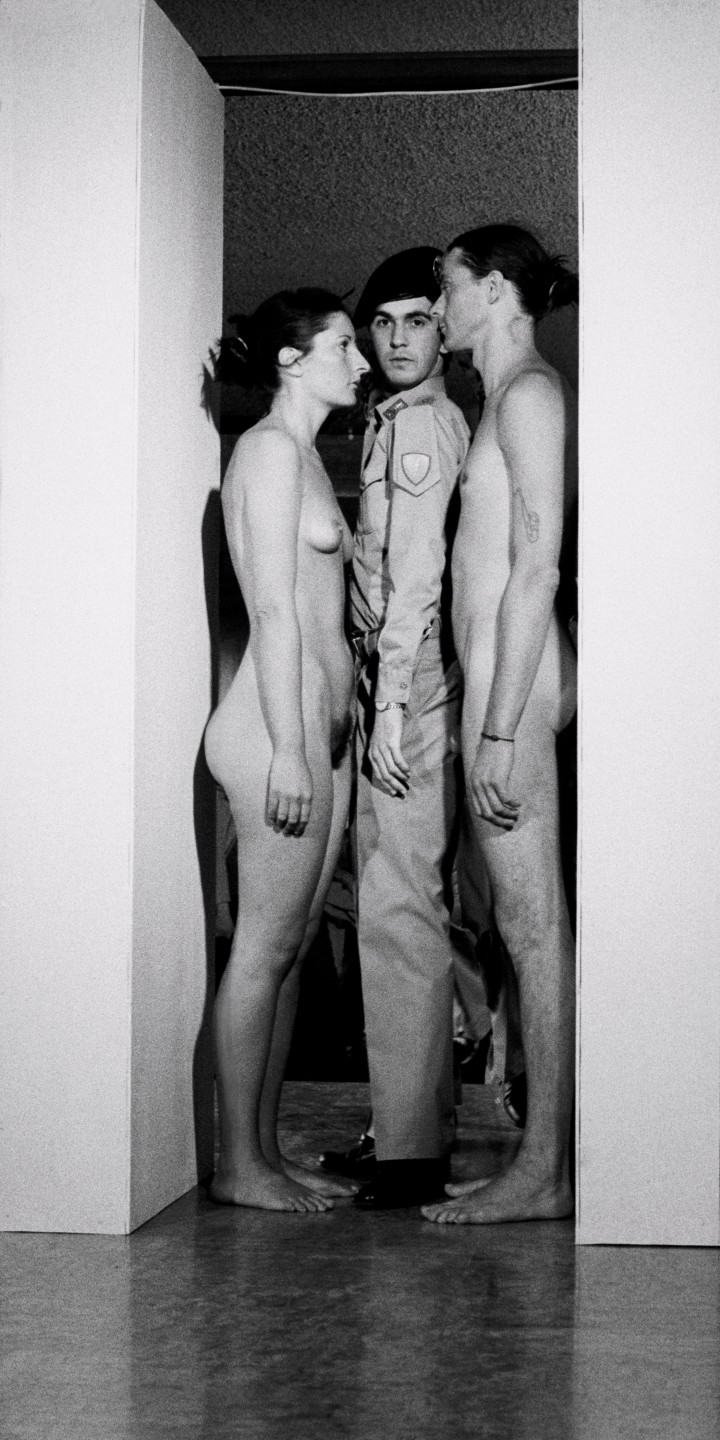Scottish Art News
Latest news
Magazine
News & Press
Publications
How Marina Abramović ‘found’ her medium in Scotland
By Rachel Ashenden, 26.09.2023

Fifty years ago, the Serbian performance artist Marina Abramović ‘found’ her medium in Scotland. At the invitation of curator Richard Demarco, Abramović debuted ‘Rhythm 10’ at the Edinburgh Festival 1973. Prior to this, she experimented with an array of mediums, including sound installations which peripherally involved her body, but she lauds ‘Rhythm 10’ as her first ever body-based performance. An opportunity for radical collaboration and artistic exchange, the Edinburgh Festival 1973 supported several avant-garde artists from overseas to present wild new ideas and works in Scotland’s capital. For Abramović, the Edinburgh Festival consolidated her newfound status as a performance artist as well as sparking a chain of connections with Scotland-based galleries and curators.
 Marina Abramović, The House with the Ocean View, 2002. Performance; 12 days. Sean Kelly Gallery, New York. Courtesy of the Marina Abramović Archives © Marina Abramović. Photo: Attilio Maranzano
Marina Abramović, The House with the Ocean View, 2002. Performance; 12 days. Sean Kelly Gallery, New York. Courtesy of the Marina Abramović Archives © Marina Abramović. Photo: Attilio Maranzano
Setting her career alight, ‘Rhythm 10’ took inspiration from a drinking game played by Russian and Yugoslav peasants, ‘Rhythm 10’ is a mediation on gesture and endurance, courage and recklessness. It entailed Abramović rhythmically jabbing a knife between her splayed fingers while recording the action. Each time she missed the gap and cut her skin, she picked up a new knife from a row of ten and went again while playing the recording back to herself. When asked about the effect this had on him as a viewer, Demarco described the ‘upsetting’ sight of streaks of blood on stark white paper. On finding her medium in ‘Rhythm 10’, Abramović reflected in her bestselling memoir, ‘Walk Through Walls’ (2016): ‘No painting, no object that I could make, could ever give me that kind of feeling, and it was a feeling I knew I would have to seek out, again and again and again’. She sought that feeling of pure, unadulterated adrenaline both within and outside Scotland – again and again and again.
 Ulay / Marina Abramović, Imponderabilia, 1977. Performance; 90 minutes. Galleria Communale d’Arte Moderna, Bologna. Courtesy of the Marina Abramović Archives. © Ulay / Marina Abramović
Ulay / Marina Abramović, Imponderabilia, 1977. Performance; 90 minutes. Galleria Communale d’Arte Moderna, Bologna. Courtesy of the Marina Abramović Archives. © Ulay / Marina Abramović
Two years later, Abramović accepted Demarco’s invitation to return to Scotland, this time to participate in ‘Aspects ’75’, an exhibition of contemporary Yugoslav art, at The Fruitmarket Gallery in Edinburgh. There, she performed ‘Hot/Cold’ (1975). This piece saw Abramović seated at a table resting her hands on a thin sheet of glass covering a slab of ice while a scorching radiator dangled above. The artist shattered the glass with her bare hands, suffering cuts and second degree burns due to the dangerous combination of extreme heat and extreme cold. The audience, meanwhile, were tortuously locked into a strange dynamic between artist-turned-patient and their own morality: should they provide medical attention or silently endure the performance? According to Dr June Geddes’ research, Guardian art critic Cordelia Oliver could not resist an intervention. Although this is peculiarly omitted from Oliver’s exhibition review, Demarco testifies that the critic interrupted the performance, shouting: “I can’t stand it any longer, switch that bloody fire off.” Geddes subsequently heard another account that Oliver pulled the plug on the radiator, corroborating Demarco’s observations.
Through the transfixing testimonies and bizarre anecdotes swapped between audience members and curators, Abramović’s performances in Scotland take on a mythical status. The festival ‘Edge ’90’ brought Abramović to Scotland once again – this time to Glasgow’s The Third Eye Centre. There, she enacted ‘Boat Emptying, Stream Entering’, a performance which marked her return to solo work after a psychic split from her artistic and romantic partner, Ulay. According to ‘Edge ’90’ organiser Nicola White, Abramović planned for five pythons (representing the five elements) to crawl over her body while encircled by ice. However, one python, named Solomon, mysteriously escaped before showtime, and remained lost for almost a year in the building. Another rogue python zoomed past the audience and towards the fire escape; fortunately, it was deftly captured by a snake handler. Uniquely, the full story of Solomon’s escape was published by the Dublin Review in 2017, but beyond White’s account, it otherwise remains imbued with anecdotal mystery.
 Rhythm Series 1973-74, Maria Abramovic, image courtesy of Wikipedia
Rhythm Series 1973-74, Maria Abramovic, image courtesy of Wikipedia
Five decades have passed since Abramović ‘found’ her medium and presented it to the art world in the Edinburgh Festival. As the first woman artist to occupy the Royal Academy’s main gallery space in a major retrospective, the remarkable trajectory of Abramović’s career, along with the evolution of her artistic method, is ripe for critique. In a contemporary culture where duty of care (for both audiences and performers) is continuously under reflection, radical body art such as ‘Rhythm 10’ would struggle to pass the curatorial risk assessments; instead, her first body-based performance will be celebrated through photographs in the exhibition. In combination, ‘Rhythm 10’, ‘Hot/Cold’ and ‘Boat Emptying, Stream Entering’ were violent actions which presented unique and unknowable risks. Needless to say, there will be no runaway pythons or second degree burns at the Royal Academy, but live performance will still take centre stage as four of her actions will be reperformed by artists trained by the Marina Abramović Institute. In dialogue with Abramović’s volatile performances which found her fame in the twentieth century, this retrospective offers an opportunity to consider what might be lost or gained through reproduced versions of the original actions without the artist present.
Marina Abramović’s retrospective at the Royal Academy, London, is exhibited until 1st January 2024




